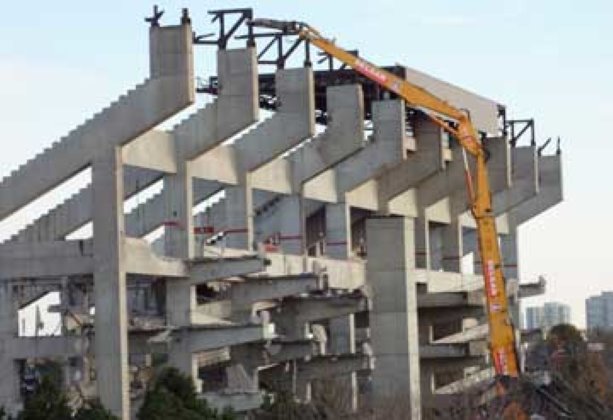This month spells the end of Ottawa landmark Frank Clair Stadium — better known to anyone over 50 as Lansdowne Park, home for decades to the CFL’s Ottawa Roughriders and the host stadium for five Grey Cups. The stadium’s remaining stands at the south end will be demolished by Concord-based Delsan-Aim Demolition Services.
This month spells the end of Ottawa landmark Frank Clair Stadium — better known to anyone over 50 as Lansdowne Park, home for decades to the CFL’s Ottawa Roughriders and the host stadium for five Grey Cups.
The stadium’s remaining stands at the south end will be demolished by Concord-based Delsan-Aim Demolition Services. The contractor’s job calls for the takedown of the stadium’s upper stands, footings/foundation and the metal truss roof over a period of four to six weeks. Completion is slated for January.
The lower south end stands were demolished in a blasting contract in 2008 after structural problems were discovered.
While the current demolition contract is not particularly complex for the contractor, it isn’t black and white either. “It is a medium-sized project for us which requires expertise in knowing how to demolish a complicated structure using specialized equipment,” explains Karim El-Khatib, Delsan-Aim’s general manager of operations.
That equipment includes of a 974 Liebherr crawler backhoe equipped with a 130-foot arm to reach the top stands and roof. A hydraulic LaBounty cutting shear and an NPK hydraulic hammer attachment will ensure the job gets done.
The stands consist of precast concrete seating and flooring supported on a cast-in-place concrete frame.
While the lower stands were demolished through a blasting process, El-Khatib says demolition with mechanical equipment was favored to meet the contract’s tight deadline. “It also made economical sense because we own the equipment and have trained operators required to demolish it.”
A strategic process for demolition/disassembly was developed in consultation with engineering firm Carvajal Structural Engineers Inc., a company that the demolition contractor frequently teams up with on projects.
The first segment of the stands demolished will be the seating and flooring, which will be crushed with the hydraulic shear, says El-Khatib.
The contractor will remove the roofing membrane by hand prior to demolition of the steel deck, open-web joists and steel truss girders which cantilever over the stands. The process is anything but haphazard. The shear will systematically cut the roof bay by bay — each bay dropped inside the remaining concrete cast-in-place frame.
Throughout the demolition, the playing field will remain available for soccer. “We have to be careful because it is only 40 or so feet way,” says El-Khatib, adding that noise barriers won’t be required because of the segmental method of demolition.
The lower portion of the cast-in-place concrete frame of the stands will be demolished using a John Deere 650 with an attached hydraulic hammer.
El-Khatib says mechanical equipment gives the contractor more control over dust and other emissions than blasting would.
Even before demolition commenced, the stadium’s mercury bulbs and light ballasts that contain PCBs were removed, properly sealed in containers and sent to a disposal facility.
The contractor’s job also requires the removal of pigeon droppings, deemed a biological hazard, says El-Khatib. “We neutralize it with a chemical, bag it and dispose of it as normal waste.”
The remnants of the stadium will be recycled. The concrete, for instance, will be crushed on site and reused by the owner as granular B fill material, says El-Khatib. The “engineered fill” can be used in concrete mixes, as a road material or for backfill.
Steel from the roof and rebar will be separated, prepared and recycled by American Iron & Metal, Delsan-Aim’s parent company.
The contractor’s winning bid for the demolition job was $550,000, considerably less than the price the city paid to demolish the lower stands in 2008, a price that topped $1 million.
The site is planned for a commercial/retail redevelopment with housing units. Plans, meanwhile, for a new stadium are elsewhere in Ottawa.



Recent Comments
comments for this post are closed